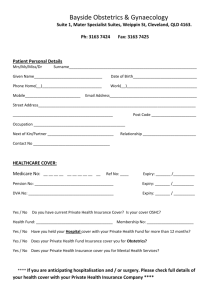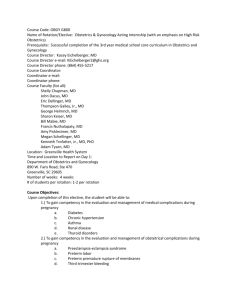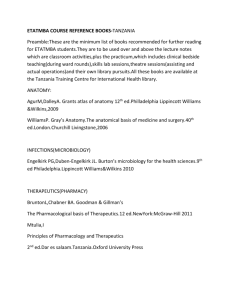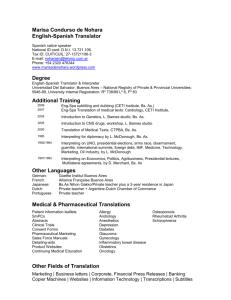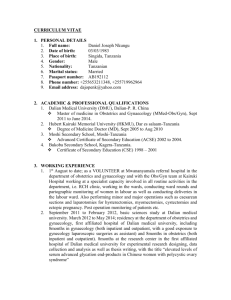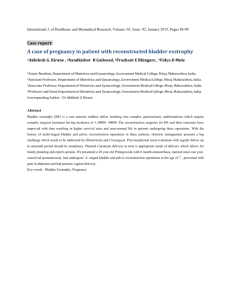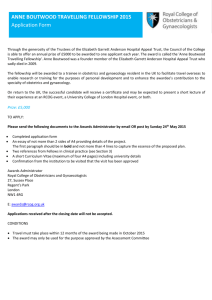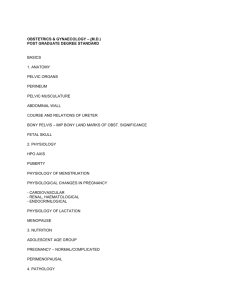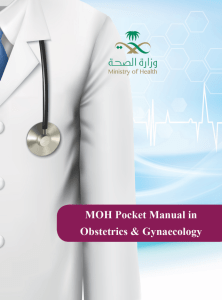Clcik here
advertisement
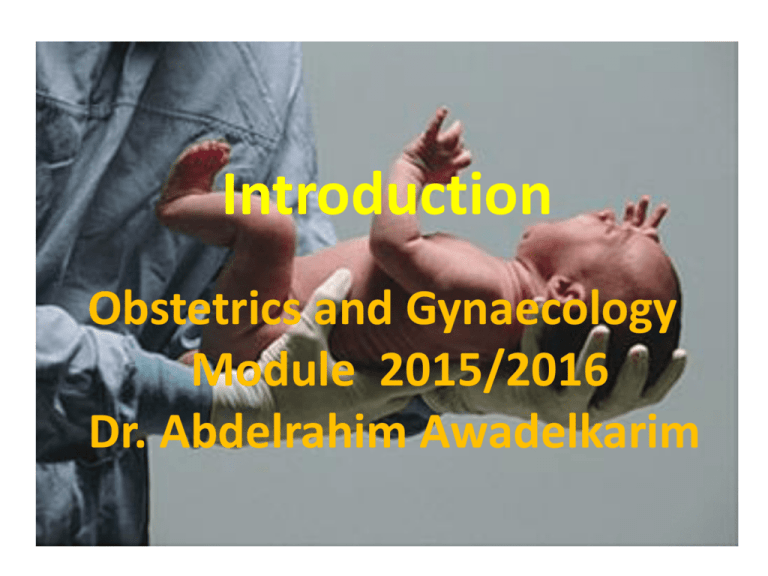
Introduction Obstetrics and Gynaecology Module 2015/2016 Dr. Abdelrahim Awadelkarim Introduction Objectives of the lecture: Definitions. OVERALL OBJECTIVE OF THE COURSE. Teaching strategies during this course. Course Learning Outcomes. ASSESSMENT. The Course References. Welcome to the “new obstetrics and gynaecology” module. This is a relatively new comprehensive module. Definition • obstetrics is the specialty of medicine’s contact with pregnant woman. Obstetrics (from the Latin obstare, "to stand by") is the surgical specialty dealing with the care of women and their children preconception , during pregnancy (prenatal period), childbirth and the postnatal period. It demands set of fundamental principles and definitive professional responsibilities. Definition • Gynecology is the medical practice dealing with the health of the female reproductive system (uterus, vagina, and ovaries as well as related pelvic structures). Literally, outside medicine, it means "the science of women". • Obstetrics and gynaecology responsibilities are in commitment to lifelong learning and professional competence, honesty, maintaining confidentiality, appropriate relationships with patients and colleagues. • Over this period, students will be equipped to expand their clinical skills through the acquisition of knowledge. THE OBSTETRIC AND GYNAECOLOGY COURSE OVERALL OBJECTIVE 1. Knowledge Graduate should have sufficient knowledge and understanding of: a. The relevant anatomy, function and development of the female genital tract and the interaction between genital system and other body systems. b. The normal physiology of, puberty, onset of menstruation, and menopause. c. The normal pregnancy and childbirth, the principles of antenatal and postnatal care. d. The normal physiology of the fetus and placenta 1.Knowledge (cont.) e. The aetiology, pathogenesis, clinical presentation, natural history and prognosis of common pregnancy related complications affecting women, particular those which pose acute danger to function, life or the community. f. Common diagnostic tests and procedures, used in obstetrics and gynaecology its application, limitations and costs. g. The management of common medical and surgical conditions in pregnancy. Con. h. The management of common medical and surgical conditions affecting non-pregnant women. i. The principles of health education and disease prevention in the care of women at different stages of their lives. j. The principles and ethics related to woman health care and the responsibilities of the obstetrician and gynaecologist Con. 2. Skills Graduate should acquire the skills of : a. Take a tactful, accurate and organized medical history . b. Perform a gentle and accurate physical examination. c. Integrate history and physical examination to reach a provisional diagnosis or appropriate differential diagnosis. d. Select the most appropriate and cost effective diagnostic procedures. e. Formulate a management plan. Skills (Cont.) f. Counsel patients and families clearly regarding diagnostic and therapeutic procedures before eliciting consent. g. Perform common life-saving procedures . h. Know how to perform office procedures . i. Use information resources to obtain further knowledge and interpret medical evidence critically and scientifically . j. Communicate clearly and considerately with other health professionals . 3. Attitudes Con. Graduate should have the attitude of a. Respect for every woman being and abide by ethical principles. b. Cultivate a desire to ease pain and suffering including psychological pain. c. Willingness to work in a team with other health professionals. d. Responsibility to develop and maintain life-long learning attitude. e. Cultivate a professional and ethical attitude in patient management. Course Learning Outcomes Knowledge: : Discuss etiology, mechanisms, morphology and effects of diseases and their clinical significance. Explain principles of various basic medical and surgical modalities and measures in the management of diseases and patient care. Recognize the life cycle and effects of growth, development, and aging upon the individual, family and community. Course Learning Outcomes Cognitive Skills : Comprehend and evaluate new information, concepts, and evidence. Establish diagnoses and therapies using sound clinical judgments. Interpersonal Skills & Responsibility: Take care of individual patient care keeping the cultures and customs of the community. Course Learning Outcomes Communication, Information Technology and Numerical skills: Provide patients with appropriate information about their medicines that improve safety and effectiveness . Use of log books and portfolios. Course Learning Outcomes Psychomotor skills : Apply sensory cues in motor activities . Show skillful performance of motor activities . Perform high levels of motor skills . Practice general and system based physical examination of patient and record observations . Teaching stratigies during this course 1) Theoretical (lectures,tutorial,PBL) 2) Skill lab. 3) Bedside teaching. 4) Afternoon hospital activities. The Course References • Ten Teachers Obstetrics 19th ed. • Ten Teachers Gynecology 19th ed. • Hacker/ Moore: Essentials of Obstetrics and Gynecology 5th ed. • William’s Obstetrics F. Cunninghm, Kenneth Leveno, Steven Bloom, John Hauth, Larry Glistrap and Katharine Wenstorm 23d ed. • William’s gynaecology F. Cunninghm, Kenneth Leveno, Steven Bloom, John Hauth, Larry Glistrap and Katharine Wenstorm The course references (cont.) • To use the resources of the medical library faculty of medicine UoH and recognized web sites • www.emedicine.com • www.studentconsult.com • www.uptodate.com • www.scog.com • www.rcog.org.com ASSESSMENT • In this Course your performance will be assessed according to the following: • Midterm written (45 MCQS) 15 Marks • Midterm OSCE (20 station) 10 Marks • Final written (60 MCQS) 20 Marks • Final OSCE (20 station) 15 Marks • Clinical examination 30 Marks • Attendance & Log book 10 Marks Total = 100 Marks INSTRUCTIONS 1. Confine to the hospital and departments rules. 2. Refrain from performing any unsupervised/unauthorized procedures. 3. Record the results of all interactions with patients in a manner laid down by the supervisor. 4. Report immediately to the supervisor any change in patient demeanor or health that occurs while the supervisor is not in the room. INSTRUCTIONS (Cont.) 5. Refrain from any clinical contact when she could potentially be impaired by drugs or disease 6. Refrain from any contact with a patient in the absence of a third person 7. Abide by the standard of ethical behavior. 8. Student is expected to conform to the dress code and dress in a professional manner. At all times student should wear his/her UNIVERSITY CARD and WHITE COAT

